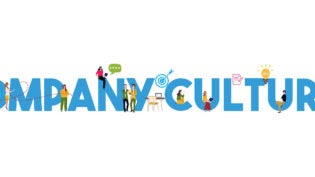5 Steps to Changing Organizational Culture and Designing Your Future Workforce
By: Redshift

When you think about all the investment you’ve made in your business—from cutting-edge tools and technology to state-of-the-art facilities—have you stopped to consider your employees, arguably the most important investment of all?
As you take your business on the continued march of technological progress, your employees need to be on board with any necessary changes for remaining competitive—whether it’s using new tools, learning new skills, taking on new roles, or sometimes all three. Your employees’ jobs will change, and it’s your job to work with them, in partnership, to ensure they’re both prepared and excited about what lies ahead. Companies that put employee learning and development first will find that their people are not only more engaged but also more productive.
Of course, it’s not enough to simply offer pep talks and training programs. You need to ensure that the organization embodies the right core set of values necessary to accomplish your business goals. Taken together, that set of values and behaviors is what defines your company culture.
Increasingly, companies are realizing that career growth is not about growing up but instead about expanding skills and experiences. There’s less need for management hierarchies and more need for people to adapt their roles and do what’s needed—right now. The most valuable employees are those who have a variety of skills and experiences and can use them in an agile way, as soon as the work is needed.
Whether your overarching goal is to take on a new line of business, digitize your processes, or increase automation, it’s important that the way you behave as a company—through the everyday actions of employees and interactions with customers—puts you on the path to success.
When Autodesk set the goal of moving to a subscription-based business, company leadership knew change was necessary because the company as a whole would be engaging with customers differently. Without revisiting the company culture, Autodesk would not be able to deliver on business goals and truly create value for our customers.
Now the question for you is, do your organization’s strategic objectives require a refresh of your company culture? If so, you can start by creating a change plan that incorporates these five steps:
1. Identify the Values and Behaviors Your Culture Should Embody
Any company culture becomes a manifestation of its employees’ values and behaviors. If you want to change that, you have to be specific about what you want to change. As a first step, identify a core set of values and determine the behaviors that support those values. This exercise includes incorporating elements that have served you well, in addition to new values and behaviors necessary to achieve your company’s long-term goals.
Whatever the culture map may be, the most important thing is to be as deliberate as possible in defining what your culture should look like. Otherwise, as new employees join (particularly when you’re growing quickly), the culture becomes whatever they interpret it to be, which is confusing and a hindrance to success. Taking the time in the beginning to be clear about where you’re headed can help accelerate the journey more than you can possibly imagine. This is particularly important because you will likely encounter people within your organization who perceive the development of a formal culture framework as unnecessary—or even a distraction from achieving the company’s objectives.
2. Craft a Communication Plan So Employees Understand What Is Expected of Them
It’s one thing to define a culture plan, but if you don’t communicate that to the organization, it’s all for naught. The key, especially when first rolling out the culture framework, is to create engaging, interactive communications that allow for employees to provide feedback. These can include in-person workshops that get your workforce thinking through new concepts; all-hands meetings at the company and business-unit level to show early advocacy from leaders; and more “supporting” communication activities such as email, intranet, internal social channels, and so forth. Incorporating a feedback loop is critical because it will be important to gauge how the new culture framework is landing across the organization.
Remember that you’re not trying to teach anybody anything; you’re just trying to help them understand. It’s about helping your employees ask questions, engage with the values, and connect them to their everyday work. That will not only create a deeper understanding of the desired culture but also connect employees to the broader success of the company.
3. Operationalize New Culture Values by Incorporating Them in Key Talent Programs
One surefire way to make the culture real is how you hire, promote, and reward employees. When it comes to the hiring process in particular, your culture will play out in how you measure and assess candidates, as well as in the hiring experience you give them. That experience starts the second that first contact is made and encompasses every touch point, from emails to screening calls to on-site interviews. Candidates quickly get a feel for the company and decide whether it’s the right place for them. If it is, upon joining, they’re immediately ready to infuse the culture with all the things you’re trying to proliferate throughout the business.
Operationalizing culture also requires going deeper than just the initial rollout and socialization of the culture framework. You should select a few key values and conduct time-bound, focused explorations of how the values show up in employees’ everyday work. This can and should include small guided, interactive sessions at all levels of the organization. By sequentially hitting some of the key values over the course of several months, quarters, or even years, your company can deepen the impact and value of its culture-transformation effort—always remembering that time spent in the near term leads to long-term acceleration for the business.
4. Use New Offices or Locations as Opportunities to Jump-Start the New Culture
As you open a new facility or enter a new market, recognize that as an opportunity to fire up the changes you’d like to instill in your organization. That unique moment when you’re starting from scratch is the perfect time to create that place as the role model for the rest of the company. It can actually move the culture transition forward much more quickly because you can shape what you’re trying to do in the rest of the company in an accelerated way.
Autodesk had exactly that chance with its new office in Dublin, where the need to quickly fill 200 of the 1,000 open positions available worldwide meant that the new cultural initiatives could be applied not only in the hiring process but also in new-employee onboarding. That unprecedented number of job openings led to a rapid and significant influence on the culture, providing a model for desired outcomes everywhere else.
5. Ensure Your Leaders “Walk the Walk”
This should go without saying, but it’s imperative that company leaders, at all levels, show the greater workforce that all of this culture work isn’t just fancy wording for the organization’s website—but that leadership actually believes that this set of values and behaviors is the right way forward and fundamental to the company’s success. It takes a lot of dedication because company leaders, especially executives, need to model the culture you want the rest of the company to emulate, and you must be aligned if you want the rest of the company to follow you.
For any company embarking on a journey like this, it is important to recognize that this is a multiyear effort. You will test, pilot, assess, adjust, and eventually come to a culture framework that is final but still always evolving. Don’t forget that the employees of your company ultimately own the culture and get to shape it. But as a leader, you can provide the guideposts that your workforce can put into practice, providing a better experience on the job, improved customer relationships, and ultimately a more thriving business.












